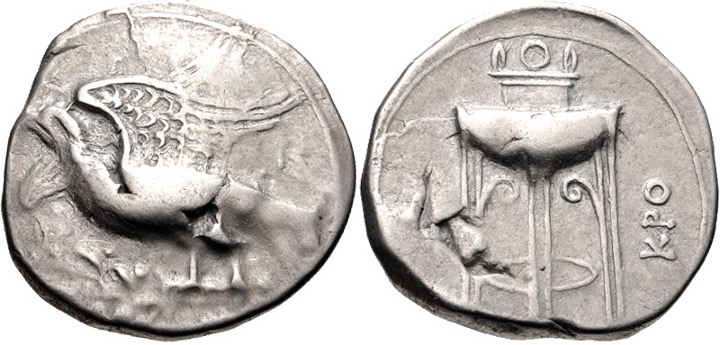2404 - Croton (nomos eagle/tripod) over Corinthian type (Pegasus/Athena) (CNG, EA 288, Oct. 2012, 67)
From SILVER
350 BCE - 300 BCE | ΚΡΟ
Location/history
| Sale(s)Sale(s) ᵖ: | Classical Numismatic Group, EA 288, 10 Oct. 2012, 67 | |
Overstriking coin
Description
| ObverseInscription or printing placed on the obverse.: | Eagle standing left on olive branch, with wings displayed and head raised. Linear border. | ReverseInscription or printing placed on the reverse.: | ΚΡΟ (Greek) Tripod. In left field, Δ (?). |
Mint and issuing power
| MintIdentifies the place of manufacture or issue of a numismatic object.: | Croton | Ancient regionAncient region. | Bruttium | Modern countryModern country: Italy | AuthorityIdentifies the issuing power. The authority can be "pretended" when the name or the portrait of X is on the coin but he/she was not the issuing power. It can also be "uncertain" when there is no mention of X on the coin but he/she was the issuing power according to the historical sources: |
Chronology
| FromIdentifies the initial date in a range assigned in a numismatic context. 350 BCE toIdentifies the final date in a range assigned in a numismatic context.. 300 BCE | Classical 480-323 BC |
Physical description
| MetalThe physical material (usually metal) from which an object is made.: Silver |
WeightWeight of the numismatic object (in grams). in grams: 7.787.78 g <br />7,780 mg <br /> | DenominationTerm indicating the value of a numismatic object. Examples: tetradrachm, chalkous, denarius.: nomos | AxisDescribes the directional relationship between the obverse and reverse of a numismatic object.: 88 mm <br />0.8 cm <br /> |
| DiameterDescribes diameter of an object (in mm).: 2222 mm <br />2.2 cm <br /> | StandardStandard.: Achaian | ||
References
| Coin referenceReference of the Coin: | Coin series referenceReference to coin series study: | HN Italy1HN Italy, n° 2172., HGC 12HGC 1, n° 1464 var. | |
| Coin series web referenceCoin series web references: | |||
Overstruck type
Description
| ObverseInscription or printing placed on the obverse.: | Pegasus flying to left | ReverseInscription or printing placed on the reverse.: | Head of Athena to left, wearing Corinthian helmet |
Mint and issuing power
| MintIdentifies the place of manufacture or issue of a numismatic object. ᵖ: | Corinth | Ancient regionAncient region. ᵖ | Peloponnesus | Modern countryModern country: Greece | AuthorityIdentifies the authority in whose name (explicitly or implicitly) a numismatic object was issued. ᵖ: |
Chronology
| FromIdentifies the initial date in a range assigned in a numismatic context. 400 BC toIdentifies the final date in a range assigned in a numismatic context.. 300 BCE | periodTime period of the numismatic object. |
Physical description
| DenominationTerm indicating the value of a numismatic object. Examples: tetradrachm, chalkous, denarius. ᵖ: | stater |
References
| Coin type referenceReference to coin series study ᵖ: | Ravel 19483Ravel 1948, Calciati 19904Calciati 1990 |
Additional data
| Frequency of overstrikesFrequency of overstrikes: | rare and concentrated | Level of confidenceLevel of confidence of the identification: | sure |
| RemarksRemarks: | Overstruck on a Corinthian-type stater with Athena’s profile visible on the reverse. | ||
References
- ^ Rutter N. Keith et alii (eds.) (2001), Historia Numorum Italy, London, xvi, 223 p., 43 pl.
- ^ Hoover, Oliver D. (2018), The Handbook of Greek Coinage Series, Volume 1. Handbook of Coins of Italy and Magna Graecia, Sixth to First Centuries BC., Lancaster-London, 2018, lxi, 527 pages, 23 cm
- ^ Ravel, Oscar E. (1948), Les "Poulains" de Corinthe : monographie des statères corinthiens. Tome II: (de 414 à 300 J. C.), London, 310 p., 54 pls.
- ^ Calciati, Romolo (1990), Pegasi, Mortara, Edizioni I.P..

